Chongqing Zhongzhou 2-day 1-day tour and night watch 'The Three Kingdoms of Flames and Smoke'
The county princess is here again to recommend the Chongqing county magic game to you. This time, I went to Zhongxian, also known as Zhongzhou, for two days over the weekend. Zhongxian County is the only prefecture and county city in Chinese history named after "loyalty", and the most famous place is Zhongzhou fermented bean curd. This time, I want to see the large-scale landscape live show "The Three Kingdoms" in the evening.

Departure: Chongqing Yuzhong District - Zhong County
Method: Self driving
Single sided: 170 kilometers (slightly 2.5 hours) toll fee of 120 yuan
Ticket: Zhongzhou Museum: Free Bai Gong Temple: Free 30 yuan/person "Smoke and Fire Three Kingdoms" Performance: 170 yuan/person
Day 1: Chongqing - Bai Gong Temple at Zhongzhou Museum in Zhongxian County to watch "The Three Kingdoms of Flames and Smoke"
The next day: Return to Citrus Culture Space Museum
Don't go back the whole way!

Sleep: Zhongyi Hotel
Zhongxian is a small mountain city with mountains and water, and the terrain is also uphill and steep, similar to Wanzhou. It is also a memory of old Chongqing. I chose to stay at the Zhongyi Hotel located on Binjiang Road this time. The Zhongzhou Zhongyi Hotel, which only opened on November 25th, 2018, really amazed me!

Not only is the price cheap, but the service and hardware facilities are also on par with big cities, making it the best hotel in Chungju. Come and experience the price:

Zhongyi Hotel is located on Binjiang Road in Zhongxian County, where you can directly enjoy the river scenery. And the new Chinese style looks very high-end.

As soon as I entered the lobby, I was amazed by the cold toned lighting effect of traditional ink canvas, combined with small landscape plants, creating a bold and atmospheric atmosphere.
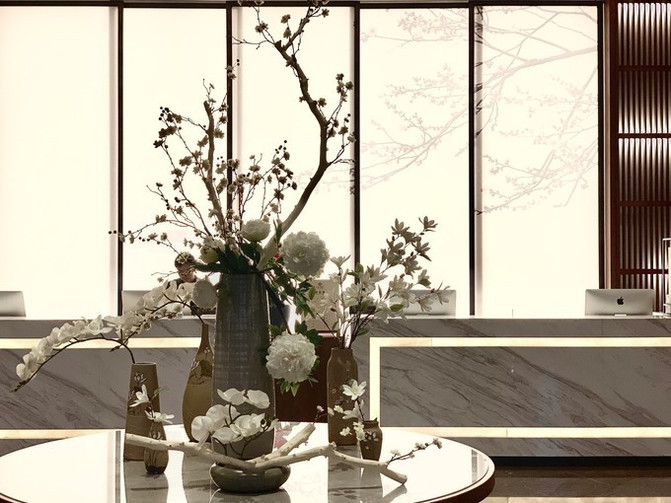
The entire hotel is centered around "loyalty" and "righteousness", connecting various lobby lounges, dining rooms, conference rooms, and rooms.

The lobby provides free black tea and lemon water for pick-up and drinking.

The corridors are adorned with "Chinese style" decorations everywhere.

The color of the seats in the lobby bar is quite nice, light navy blue, soft lighting, quiet environment, very antique.

The room space is spacious and transparent, fully decorated according to modern guest room standards. The 'work area' in the following picture looks quite nice.
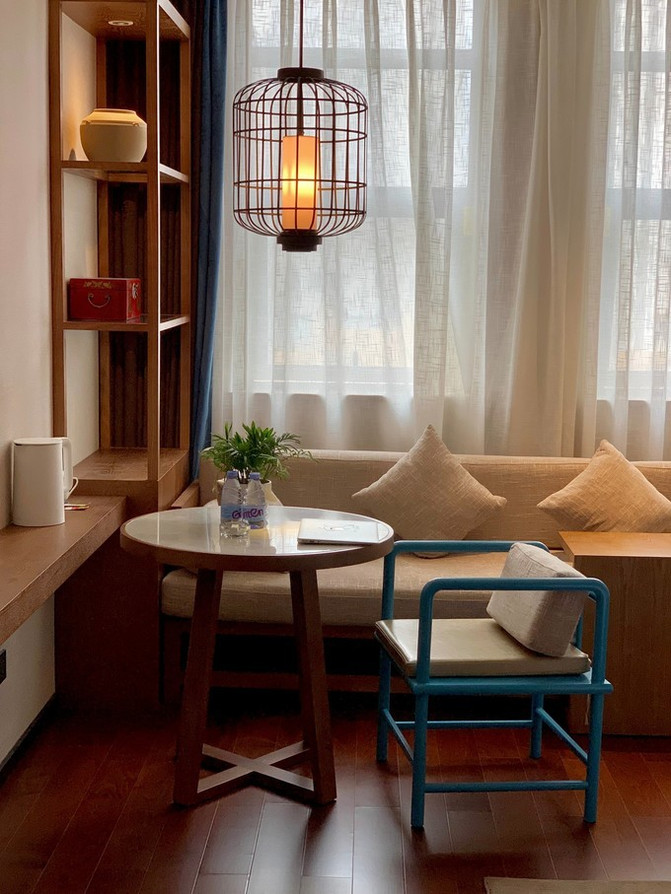
The bathroom, shower room, and washbasin are all located in three separate open areas.

There were no doors separating the entire room, and only after I finished taking a shower did I realize there was a thick curtain that could cover it.

In addition to the plug, the plug can also be directly plugged in. Milk can be provided for free in the evening, with hot and cold options to choose from.

The deep-rooted hobby of the Sichuan people is mahjong, so some rooms provide dedicated mahjong rooms.

There are restaurants on both the first and third floors, with open lobbies and compartments, offering both privacy and openness options.

And because it is close to the river, you can see the night view of Zhongzhou. The night view of Zhongzhou is quite beautiful, perhaps because it is related to the terrain. The characteristics of the mountainous area make the entire city seem to be suspended in the sky:

And the high-rise buildings along the river still have a light show, lively and graceful.

It's already good to have such a high standard hotel in Zhongxian, and it's still on Binjiang Road. The price is only three to four hundred, which is not bad.
View: Chungju Museum
My first stop after checking in was the Chungju Museum. To understand a city, one must first start by understanding its history, especially in Zhongzhou where there are loyal and righteous individuals such as Ba Manzi, Gan Ning, Yan Yan, and Qin Liangyu. In the eighth year of the Tang Dynasty's Zhenguan reign, Zhongxian County, which was named Zhongzhou, can be considered a significant historical presence in Chongqing, starting from the Zhongba culture 5000 years ago.

The museum currently has a collection of over 20000 pieces/sets of cultural relics, covering 23 categories of cultural relics, including the entire period from the mid to late Neolithic Age to modern times.
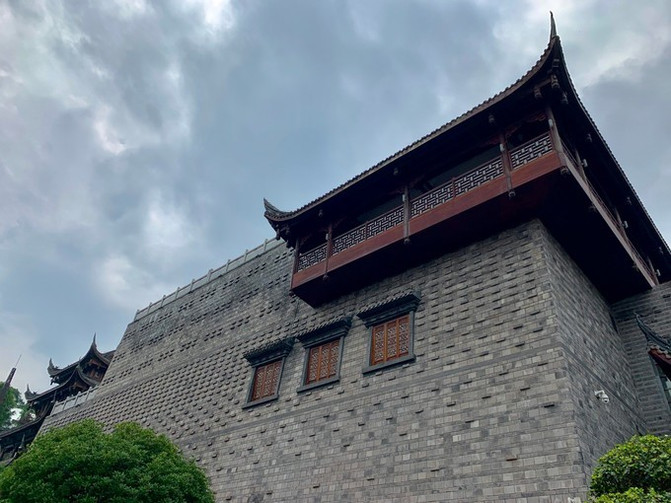
There are two entrances to the Chungju Museum, one on the first floor and the other on the second floor with a partial staircase. I suggest starting from the entrance on the first floor and looking at the entire history, culture, and intangible cultural heritage of Chungju from ancient times to the present.

The Zhongzhou Museum covers an area of 36 acres, with a building area of 15000 square meters and an exhibition hall area of 6000 square meters.

The museum has the "Ten Treasures of the Town Hall", including the Eastern Han glazed pottery bell, the Warring States bronze axe, the Tang auspicious beast grape patterned copper mirror, the Qing printed yellow glazed porcelain bowl, the Eastern Han bronze dove head, the Han three branch bronze lamp, the Southern Dynasty "Two Zhu" copper coin, the "Yongguang" copper coin, and the "Jinghe" copper coin.

There are three major sections in total: "Humanistic Zhongzhou", "Loyalty and Righteousness Zhongzhou", and "Colorful Zhongzhou". Among them, "Humanistic Zhongzhou" is located in the middle of the museum building, showcasing the magnificent history and culture of Zhongzhou for thousands of years;

During the Ming and Qing dynasties, Zhongzhou attached great importance to culture and education by renovating study halls, establishing academies, donating and buying study and temple fields, forming two new and old study halls; The unique scenery of two academies in one state (White Deer and Shao Goose). According to incomplete statistics, during the Ming and Qing dynasties, there were 38 Jinshi candidates, over 150 Jurchen candidates, and over 330 Gongsheng candidates from Zhongzhou.

From the late Neolithic period to the 1970s and 1980s, the salt production of Zhongzhou pottery has not been interrupted for thousands of years. The excavation of the salt boiling relics of Zhongba pottery provides extremely valuable physical materials for the study of the production mode of pre Qin salt industry in China, and also reflects the advanced production technology of salt industry in Zhongzhou during the pre Qin period.
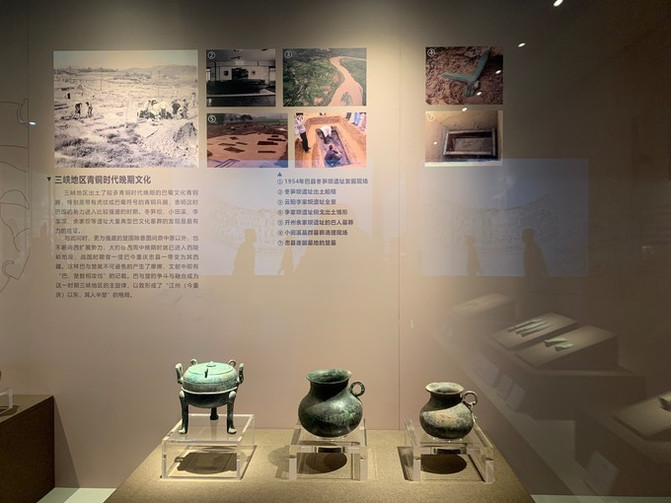
Zhongyi Zhongzhou "is located in the attic at the west end of the museum, displaying the loyal deeds of the ancient sages and modern heroes of Zhongzhou throughout history;

The entire Chungju Museum is much larger than I had imagined.

In addition to the conventional display of graphics and text in display cabinets, advanced display methods such as art scenes, 3D sand tables, AR systems, holographic projection, phantom imaging, and multimedia efficiency enhancement are also fully utilized in conjunction with exhibition highlights.

Carefully arranged scenes include a 12 meter high Zhongba cultural stratigraphic wall, large-scale pottery salt making, and the Linjiang team zinc smelting site.

These exhibition sections are both independent and intertwined in content, showcasing the archaeological achievements and cultural research of the Three Gorges Reservoir Area in Zhongzhou, as well as providing a comprehensive understanding of the history of Zhongzhou through large-scale thematic exhibitions.

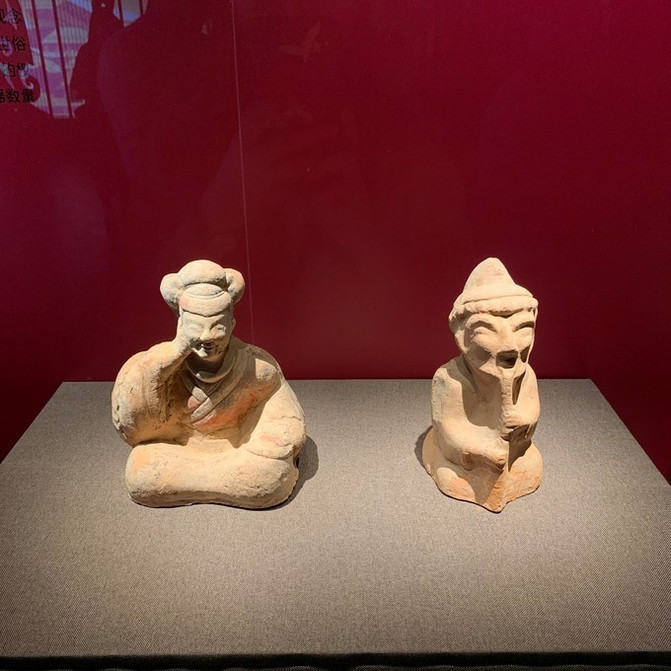
This dancing 'music and dance figurine' is so cute, I really like it:

And this golden hairpin, oh my, it deeply touches my heart and makes me happy to see it.

After the mid Western Han Dynasty, Confucianism became the dominant religion, filial piety governed the world, and the trend of lavish funerals emerged in the Han Dynasty cultural relics exhibition area. The large number of bronze vessels and other gold, silver, bead, and jade ornaments unearthed from tombs in Zhongzhou during the mid Western Han and Eastern Han dynasties are a manifestation of this style of heavy burial.

There are also murals depicting the past way of life in Chungju, which are very vivid.

"Colorful Zhongzhou" is located in the Ming and Qing style quadrangle at the east end of the museum, which displays the unique intangible cultural heritage and folk customs of Zhongzhou, including: Zhongzhou fermented bean curd steamed tofu with stone treasure, high platform lion dance, cattle dwarf dance, bridal chamber flower candle hall full moon wine

Shibao steamed tofu, hot dish, with a bright red color, salty and slightly spicy, tender and refreshing. It is a traditional famous dish of Han nationality in Zhongxian County, Chongqing. It was originally a Buddhist Food dish of Shibaozhai Temple in Zhongxian County, and later spread to the people, so it is called Shibao Steamed Tofu. Awarded the title of "Chinese Famous Snack" by the China Hotel Association. In 2009, it was included in the second batch of municipal intangible cultural heritage list in Chongqing.

Zhongzhou fermented bean curd, also known as Zhongxian fermented bean curd, is produced in Zhongxian, Chongqing. Zhongzhou fermented bean curd started in the Tang Dynasty and flourished in the Qing Dynasty. It has been thriving for more than a thousand years. The strain used is isolated from the mold room that was used since the 12th year of Yongzheng's reign in the Qing Dynasty. Its enzyme system diversity and decomposition ability are unique throughout the country. In 2009, Zhongzhou fermented bean curd production skills were included in the second batch of intangible cultural heritage list of Chongqing. In March 2012, the AQSIQ approved the implementation of geographical indication product protection for Zhongzhou fermented bean curd.

After one month of birth, a "Full Moon Wine" will be held to wish the child a smooth growth.

The traditional dance "Zhongzhou Dwarf Dance" that has been passed down in the Zhongxian area of Chongqing may seem strange, but now it has become an intangible cultural heritage of Chongqing. The Zhongzhou Dwarf Dance, which was included in the third batch of municipal intangible cultural heritage list as early as 2011, evolved from the folk game "Hidden Cat".

Originally spread in the Shuanggui and Xinli areas of Zhongxian, it has gradually spread to some areas along the Yangtze River and its tributaries in Zhongxian. Dwarf dance "is a field entertainment dance that celebrates a bountiful harvest. During the harvest season, villagers move their clothes down their stomachs and draw their facial features on their stomachs with soil, which is called" face "; Cover your head with a large bamboo basket, then turn it into a "hat" and dance casually.
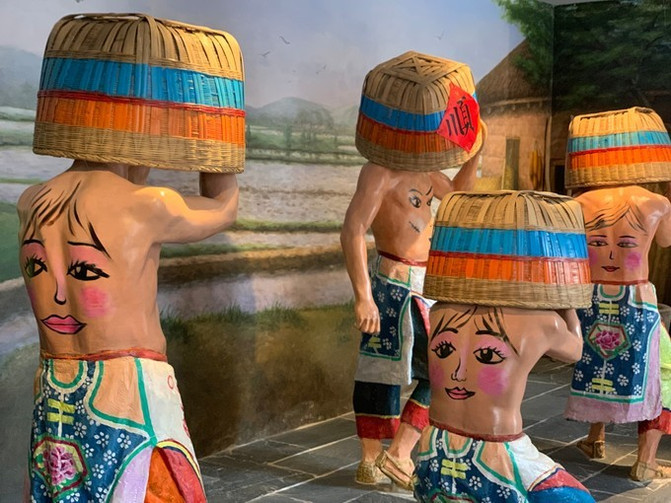
In the past, every New Year's Day, the Dafengshou (Salad of assorted fresh vegetables) would be celebrated by lion dance, and a bullfight would be held with the water buffalo in the field.

Gaotai Lion Dance has been listed as a representative project of intangible cultural heritage. Named after building a high platform with the help of ordinary farmhouse dining tables and dancing "lions" on it. The "Gaotai" wooden table should have seven, nine, or twelve extra tables, with a total height of about 10 meters. There are two types of construction methods: "one stick incense style" and "one stick incense style".

In traditional residential buildings in Zhongzhou, the main hall is the living and activity space of old style Han residential buildings, usually designed in the middle of the house, also known as the "guest hall".

Long ago, people used to refer to the new house where the newlyweds got married as the "bridal chamber".

Many of the works in this exhibition are also exhibits of the Joint Three Gorges Museum.

The entire museum design is of high standard.

There are various cultural and creative products in the Zhongzhou Museum, which also reflect the national style.

Looking down from the courtyard, there happens to be a "face changing" performance:

The Zhongzhou Museum is a Ming and Qing style antique building with a grey wall and black tiles as its main theme. The side features a three layered fire sealed wall, and the ground and stone steps are paved with granite. The railings are made of granite reliefs, exuding an antique charm.

After visiting the Zhongzhou Museum, you can directly walk from the third floor indoor to another attraction across from you: the Bai Gong Temple. The Bai Gong Temple and the Zhongzhou Museum are simply door to door, household to household, connected together.
Step: Bai Gong Temple
The Bai Gong Temple in Zhongxian was built in the third year of the Chongzhen reign of the Ming Dynasty to commemorate the Tang Dynasty poet Bai Juyi, who served as the governor of Zhongzhou. The ticket is 30 yuan.

Built in memory of the great Tang Dynasty poet Bai Juyi, who once served as the governor of Zhongzhou, it is one of the two Bai Juyi Temples on par with the "Tang Shaochuan Bai Gong Tomb Temple" in Xiangshan, Luoyang. The temple was first built in the third year of the Chongzhen reign of the Ming Dynasty and was later destroyed by a large fire. It was rebuilt during the Republican era.

After visiting the indoor museum, taking a walk outdoors is also a good choice. After walking the long steps, we will commemorate Bai Juyi, a resident of Xiangshan. This is close to the highest point of the Bai Gong Temple, with a large wall filled with poems by Mr. Bai Juyi nearby. On the other side, it leads to several memorial temples, namely Qin Liangyu, Guan Yu, Bawang Temple, and Laojun Temple.

In 818 AD, the poet Bai Juyi was demoted to the position of Governor of Zhongzhou due to his open-minded political attitude. He sharply exposed and criticized the debauchery and corruption of bureaucrats in his poetry and prose, which led to criticism and rejection.

During my tenure in Zhongzhou, I cared about ordinary people, led the people of Zhongzhou to open mountains and build roads, plant trees and flowers, and shared joys and sorrows with the people. During his tenure in Chungju, he wrote over a hundred masterpieces that had a significant impact on both his time and future generations.

The people of Zhongzhou revered him and called him one of the Four Sages along with Liu Yan, Lu Zhi, and Li Jifu. In the Song Dynasty, the Four Sages Pavilion was built as a memorial.

In the third year of the Chongzhen reign of the Ming Dynasty, Ma Yicong, the governor of Zhongzhou, respected Bai Juyi and knew that he was deeply loved by the people when he was an official in Zhongzhou. Therefore, he proposed to build a temple for worship. In this way, "the thatched roofs were removed, and the daily supervision of craftsmen was carried out. In autumn, the three pillars of the hall and the two pavilions of the Drunken Song Pavilion were completed," and then the building was expanded. When Ma Yicong advocated the construction of the Bai Gong Temple, he hoped that "the future gentleman would expand it and grow together with the mountains and rivers of Bashan and Shu". In the tenth year of the Qing Dynasty's Daoguang reign, the Bai Gong Temple was expanded.


The entire Bai Gong Temple is lush with greenery, and the courtyard design preserves a considerable amount of vegetation, resembling a green park.


Baiyuan cleverly embeds the name and title of Bai Gong. The couplet 'Floating clouds are not related to fame and fortune, and the character' happy and joyful 'is written by Emperor Xuanzong of Tang when Bai Gong passed away.'.

On the high platform at the entrance, there is a pair of towering stone pillars. The two pillars in front of the pillars are more than 2 meters long, imitating the great exorcism unearthed in the Wei and Jin dynasties, which looks quite imposing. These pillars are all carefully crafted. The one in front of them is the one in front of a wealthy household at that time, with a gold ingot at the waist and a "dragon fruit" on the top of the head, symbolizing wealth and daily prosperity.

The Three Kingdoms of Flames and Smoke
Readers who enjoy the Three Kingdoms, or those who enjoy playing games and board games related to the Three Kingdoms, should come and take a look at 'The Three Kingdoms of War'. Although the name feels like the entire story of the Three Kingdoms, the main storyline revolves around Guan Yu, the God of Loyalty and Righteousness - revolving around his spirit of loyalty and righteousness. From encountering loyalty and righteousness to protecting them, from following loyalty and righteousness to dedicating oneself to it, every scene is meant to portray him.

This time, "The Three Kingdoms of War and Smoke" underwent several months of safety maintenance, adjustments to lighting, audio and other equipment, and changes to the program content. It is a rerun starting from April 1, 2019, at 20:00 every night. The performance venue is located by Dongxi Lake in Zhongxian County, about 10 kilometers away from the county seat. Ticket prices: regular ticket 120, guest ticket 150, VIP ticket 180, VIP ticket 688.

The Dingzu Square is sculpted with three legged tripod sculptures, with the outer side of the tripod inscribed with Wei, Shu, and Wu, cleverly reflecting the historical fact of the Three Kingdoms tripod in the late Eastern Han Dynasty.

However, I think it's possible to order in advance on major apps for a cheaper price.

The audience seats are divided into the North and South sections, and because our seats at the back can rotate 180 degrees, we enter separately. After watching the entire show, I still feel quite emotional. I think most of the current performances in China have similarities in both advantages and disadvantages. The biggest problem is that form is greater than content. The entire 'Three Kingdoms of War and Smoke' was created by a top international planning team - the original cast member of the Xi'an large-scale live action drama 'Song of Everlasting Regret', Ma Li. Of course, I am not worried about the quality at all. As far as I know, the live performance of 'Song of Everlasting Sorrow' was created in the Huaqing Pool where Yang Guifei was soaking in hot springs in the ruins scenic area, with Mount Li behind it. In the Three Kingdoms period, a group of brave and skilled warriors emerged in Zhongxian. This place is also one of the ancient sites that witnessed the fierce competition among the warlords during the Three Kingdoms period. Legend has it that the great general of Shu, Jiang Wei, once marched through Zhongxian during a war, and the place where he tied his horse was later known as "Shimalan" by later generations. The brave and extraordinary Jiang Wei shot an arrow into a well on the stone wall for the soldiers to use, and Zhongxian still retains this "Jiang Wei Well" to this day. The location where the live performance of 'The Three Kingdoms of War and Smoke' took place is exactly where Jiang Liangma lived thousands of years ago.
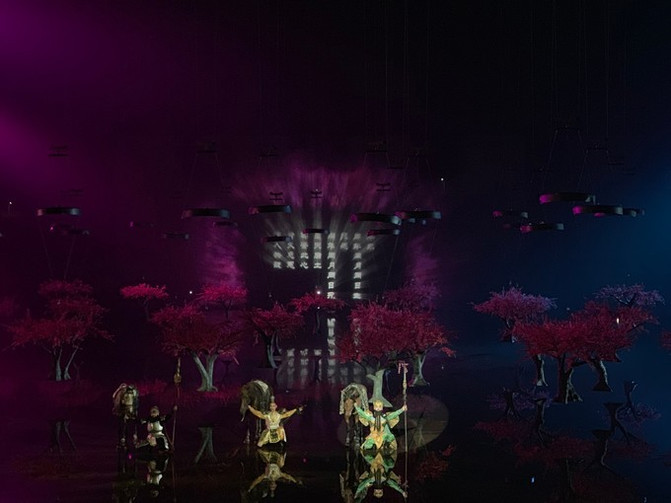
So the performance of 'The Three Kingdoms of War and Smoke' must have horses! Soldiers riding real horses perform on the water surface, as the stage and audience seats are quite close, only about 2 meters apart, and the entire stage is on the water surface. For some reason, the smell of livestock is overwhelming. Whether it's stage design or stage hardware, they are all impressive and leave a lasting impression at first glance. With a 200 square meter large 3D holographic water screen projection, a 286 meter long aerial Weiya group, and a 180 degree all-round circular rotating audience seat. Upon seeing it, the entire seat began to move, only to realize that there was a huge ancient building hidden behind us, which felt exceptionally grand. At the beginning, the hanging peach tree rises and falls to reflect the "Peach Blossom Oath", which also makes people feel like they are in a dreamlike state, with a special feeling. However, I was thinking about what role this way of lifting and lowering the "Peach Blossom Tree" into the plot, as if the creators did not want to delve into it deeply. It was just a formality that made everyone feel "wow, Peach Blossom Oath" and then there was no more.

Water surface performances are actually very visually impactful. The entire scene has a layer of water, with all the actors and horses stepping on it. With the addition of lighting effects, the scene and visuals are reflected in the water. However, the water surface stage on site is really large, making even 50-100 people gathering on the stage less than 3/1, appearing particularly spacious.

The appearance of the ancient building behind the seat promotion provides the most beautiful background for the "Diaochan" floating down from the sky.

The Three Kingdoms of Flames and Smoke depicts classic historical events such as Guan Yu's "Peach Garden Oath", "Battle of Xiapi", "Trapped in Cao Camp", "Riding Alone for Thousands of Miles", "Burning Red Cliffs", "Going to the Meeting Alone", and "Flooding the Seven Armies".

After watching the beautiful Diao Chan and palace maids dance, the seat rotates 180 degrees back to the front stage. Facing the audience is a giant stone statue column without a seat, consisting of the Five Tiger Generals, namely Guan Yu, Zhang Fei, Zhao Yun, Huang Zhong, and Ma Chao.

Because there is really no real person interpretation in this section, classic historical events such as "Crossing Five Levels and Slaying Six Generals" show us these five pillars projected on a screen, playing each of the five levels one by one, without any real person interpretation. Although I understand that using real combat may be costly and technically challenging, I still feel that this form of fighting seems a bit petty.

The function of these five pillars is not yet complete, and behind them lies the trapped Cao camp - although there are toasts and long songs and dances, they cannot shake Guan Yu's loyalty and righteousness. Burning Red Cliffs - The Battle of Red Cliffs, won by a small number and defeated the Cao army by a large margin. In these two stories, the five stone pillars transformed into boats, and the actors picked up torches and ran around inside. The feeling was still the same, the stage was too grand, and the cast of less than 100 actors couldn't hold up, bustling with people.

The fire really started on the water surface, and even I sitting in the audience could feel the heat.

I'm just shooting on the stage in the center, actually both sides are empty.

In the last scene, "Guan Yu ends the curtain", dozens of identical Guan Yu statues hanging from the air are also arranged and combined in various forms, which is difficult to understand. This scene, combined with the holographic projection of five pillars, gives a feeling of 'budget shortage, just try to fool the audience'.

It is also because the stage is too close to the audience, so you can clearly see the facial expressions of the actors. However, there have been more than one occurrence of inconsistent movements among actors and some actors dancing casually to get things done. I have also seen the O Show in Las Vegas in the United States from a close distance. Every actor, even a supporting role, is very dedicated and professional in his performance. On the other hand, in our live performance, there is a feeling that 'this soldier is a mass actor'.

Overall, form is greater than content. My impression is that the main creative team first thought of how to use special effects, stages, props, and hardware facilities to give everyone a visual surprise, but it was disconnected from the content. Shouldn't hardware infrastructure be serving content? What, it feels a bit overwhelming. Personal opinion, for reference only. Only when you see and feel it yourself will you know.

Ticket Price:
1: Adults: Regular ticket 288 yuan/person, VIP ticket 388 yuan/person, VIP ticket 488 yuan/person
2: For special groups such as people with disabilities, military personnel, and elderly people aged 70 and above (including), the following conditions must be met when purchasing half price tickets for scenic spots:
(1) Original documents need to be verified on-site;
(2) After enjoying special group discounts, you will no longer be entitled to their benefits.
(3) Local residents of Zhongxian can purchase a regular district performance ticket for 120 yuan per person with their local ID card (for personal viewing only)
3: Free ticket policy:
(1) Children under 1.2 meters in height;
(2) Journalists who come to promote and report must contact in advance with their press credentials.
Consultation hotline: 400-023-8822
Address: Three Gorges Harbor, Dongxi Lake, Zhongxian County, Chongqing, China
Food: Zhongzhou fermented bean curd Parson Orange Juice
When you come to Zhongzhou, you must buy Zhongzhou fermented bean curd. Zhongxian people took me to this Zhongzhou fermented bean curd wholesale store to buy authentic fermented bean curd. He has bought it in this wholesale store for 20 years, and this old store is in the old city of Zhongzhou.

Zhongzhou fermented bean curd with spicy and white flavor is a dazzling array of brands.

Buying a single bottle for 7 yuan per bottle is cheaper if you buy more.

There are also specialized gift box packaging, which is worry free and convenient.

After buying the specialty products, make them and return to your hometown to visit again next time.
Previous Article:Fireworks Paradise in the World Dream -9 day tour in Xizang and Chongqing
Next Article:The best one-day tour route of Dazu Rock Carvings
